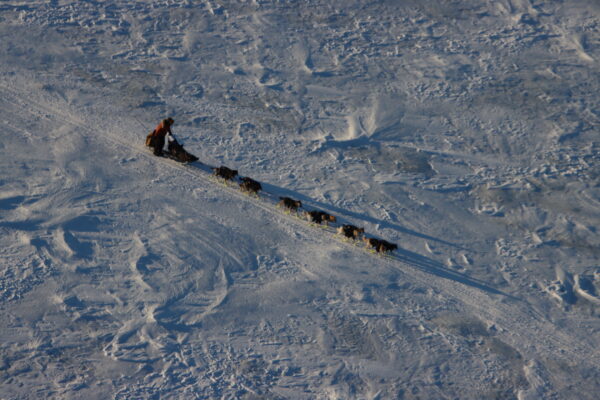
Update, 7:15 p.m.:
Brent Sass and his 11-dog team dashed out of the White Mountain checkpoint at 7:05 p.m. Monday, with just 77 miles to the finish line.
The team is fresh off an eight-hour rest. All teams must stop that long at White Mountain.
Sass has more than a two-hour lead on his closest competition: Dallas Seavey. Seavey can leave at 9:42 p.m.
Original story:
WHITE MOUNTAIN — Brent Sass is poised to win this year’s Iditarod Trail Sled Dog Race.
It’s something he’s wanted for years.
“Well,” he said, smiling and laughing after pulling into the checkpoint here Monday in first place. “Oh boy! Well, we made it!”
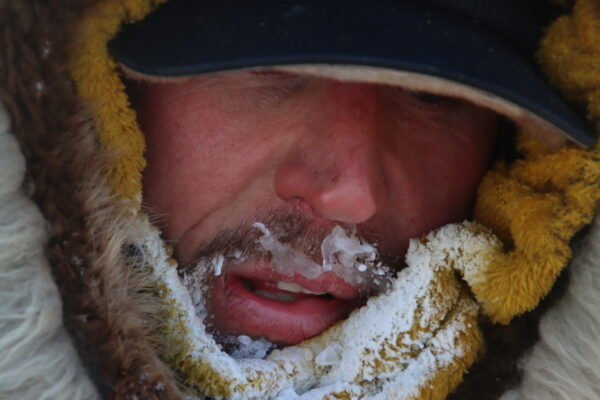
Sass and his 12 dogs raced into White Mountain at 11:05 a.m. They have just 77 miles to the finish line in Nome. And Sass’s closest competition is more than two hours behind: five-time Iditarod champion Dallas Seavey.
All teams must stop in White Mountain for eight hours before the final push to the finish.
A cheerful and tired Sass fed his dogs on the frozen Fish River near the community, preparing to rest under clear and sunny skies.
He said he still felt a little shocked to be in the lead.
“That I’m here in White Mountain, as the number one musher at this point, with one more run left to go in the Iditarod,” he said. “It’s, yeah, it’s kind of a dream.”
Sass, 42, trains out of a remote homestead in Eureka, outside of Fairbanks. He’s known as a friendly and chatty musher, but also a serious competitor who is willing to bypass the comforts of a checkpoint to camp out on the trail. While he’s won the 1,000-mile Yukon Quest three times, the highest he’s placed in the Iditarod — before this year — was third. That was last year.
LISTEN: Iditapod: A new Iditarod champion?
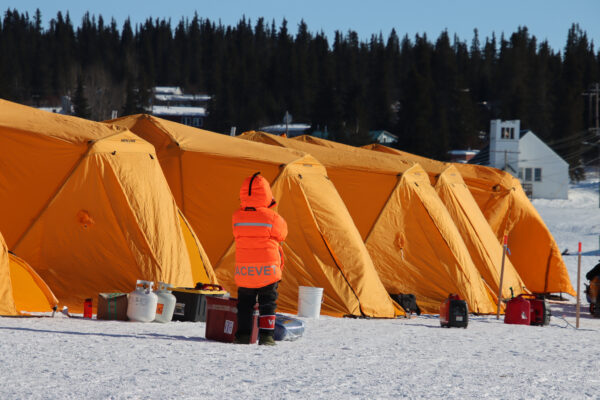
Sass raced his first Iditarod in 2012. He placed 13th, the best of any Iditarod newbie, winning him the Rookie of the Year award. He faced problems in later races. He got disqualified from the 2015 Iditarod for carrying an iPod Touch. And the next year, he tried to keep up with Dallas Seavey and his dad, Mitch. But once they got to White Mountain, his dog team refused to leave for hours. He called it, then, the most embarrassing moment of his life.
Now, he has a tattoo that says: “Run your own race.” He said it reminds him to not get pulled into his competitors’ tactics.
“My self-discipline has gotten a lot better over the last few years,” he said before the start of this year’s Iditarod. “I’m no longer the young kid on the trail anymore, which catches up with me every now and then.”
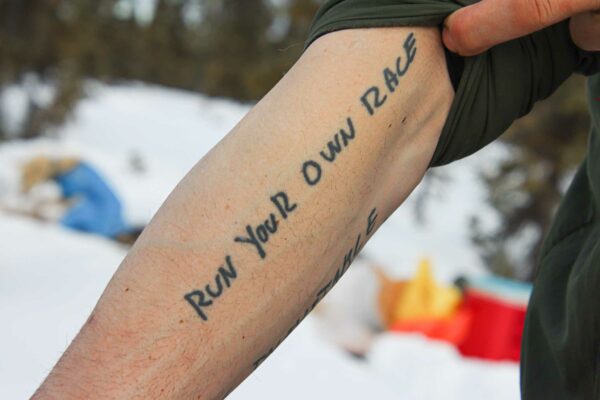
Sass went into this Iditarod coming off a winning streak. He placed first in all three of the mid-distance races he started this winter, including the Copper Basin 300, where he outran rivals like former Iditarod champ Joar Leifseth Ulsom.
In the 2022 Iditarod, he seized control of the race just before the halfway point. He passed Seavey on the trail from Ophir to Cripple, taking over the lead and never giving it up.
“It’s a little surreal to be honest,” he said at the White Mountain checkpoint. “It’s been a hell of a race for these guys and I’m super proud of them. And I’m tired — for the record.”
He laughed.
RELATED: Brent Sass interview in White Mountain
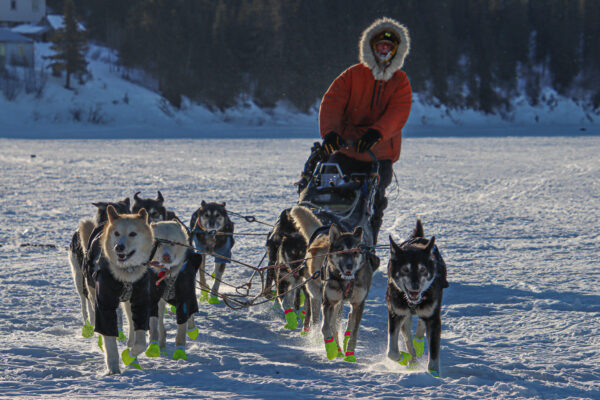
Sass said he planned to get some sleep in White Mountain. He was still processing it all.
“Eight hours is plenty of time to lay down,” he said. “But, I don’t know, I’m kind of speechless to be honest.”
Sass gave all the credit to his dog team, led most of the time by Slater and Morello.
“It’s all about the dogs,” he said. “Super proud of the dog team. “Everyone says that or whatever, but I feel like I’ve put a lot of energy into this team and they’ve poured it all out in the field.”
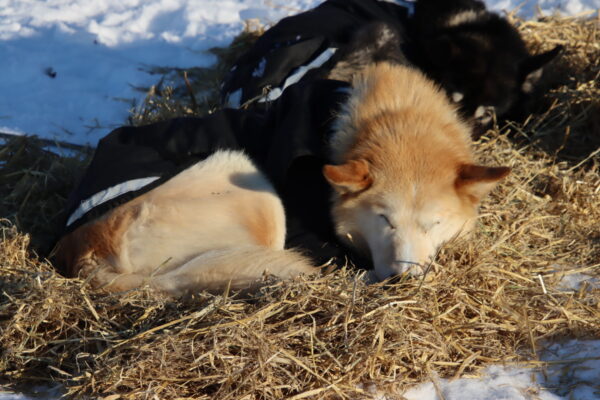
He said his dogs rallied overnight, picking up his spirits after his sled runner broke, adding an extra burden on his team as the aluminum scratched into the icy ground. He said he spent a lot of time on the back of the sled kicking his foot across the snow to help propel the team forward.
“I think my heels are bloodied from last night,” he said. “I kicked a lot last night.”
He knew Seavey wasn’t right on his tail. But he still felt worried.
“I was looking behind my shoulder the whole time thinking, ‘Oh, there’s his headlamp, he’s coming!’” he said. “Just paranoia for the most part. Because he was still quite a ways back.”
Sass did check in with the small crowd gathered at the White Mountain checkpoint Monday afternoon to ask about Seavey, learning he was more than a dozen miles away.
“A little breathing room at least,” he said. “That’s probably a couple hours, right? That’s nice.”
[Check out more Iditarod coverage here.]
When Seavey arrived in White Mountain more than two hours later, he had nine dogs pulling his sled. Another one rested in his sled bag, the result, he said, of a lingering stomach bug that has plagued most of his team since the beginning of the race.

As he heated water to make a meal for his dogs, Seavey said that he didn’t think he could catch Sass in the final run into Nome — unless an unforeseen storm or other calamity derailed Sass’s run. Seavey said he lost his chance at the win 120 miles into the 1,000-mile race, at the checkpoint in Finger Lake. That’s where he realized there was a sickness running through his dog team.
“Since then, we’ve just been trying to make the most of what we got,” he said. “And honestly, I personally am really proud of getting this team here in this position with the things we had to deal with.”
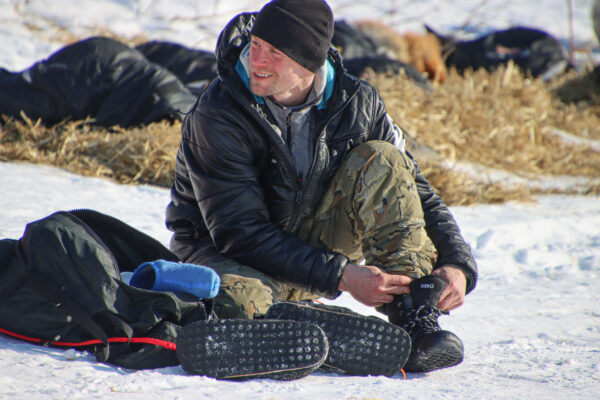
Seavey said the challenges — which included injured dogs — have also made it a mentally-taxing competition. While he said he’s been sleeping more than most races, he’s still tired from his tactical calculations.
“You’re sitting here working this problem constantly, like, ‘How do I race with this? How do I solve this problem?’ and thinking through the whole race, so I’ve been mentally going non-stop,” he said.
Seavey said this will be his final Iditarod for a while, so he can spend more time with his 12-year-old daughter, Annie. Seavey, 35, lives in Talkeetna, where he runs a sled dog kennel and tour business.
This is his 13th Iditarod. He has strong family roots in mushing. His dad, Mitch, is an Iditarod musher and racing this year. And his grandfather, Dan, helped stage the very first Iditarod.
Seavey said he’ll probably race the Iditarod again, eventually, when his daughter is a little older.
“When that day comes, it’s quite likely that I’ll come back to racing if I feel like this is what will challenge me to continue to grow as a dog musher,” he said.
Seavey was looking to win a record sixth Iditarod.
Sass, racing to win his first, can leave White Mountain at 7:05 p.m. Monday.
Seavey can leave at 9:42 p.m.
The Iditarod is expected to name a champion early Tuesday in Nome.
This story has been updated with additional details.
Lex Treinen is covering the state Legislature for Alaska Public Media. Reach him at ltreinen@gmail.com.
Tegan Hanlon is the digital managing editor at Alaska Public Media. Reach her at thanlon@alaskapublic.org or 907-550-8447. Read more about Tegan here.






